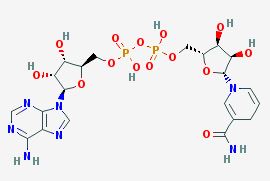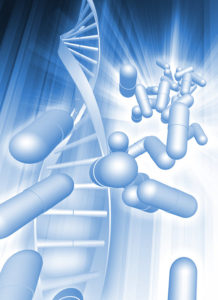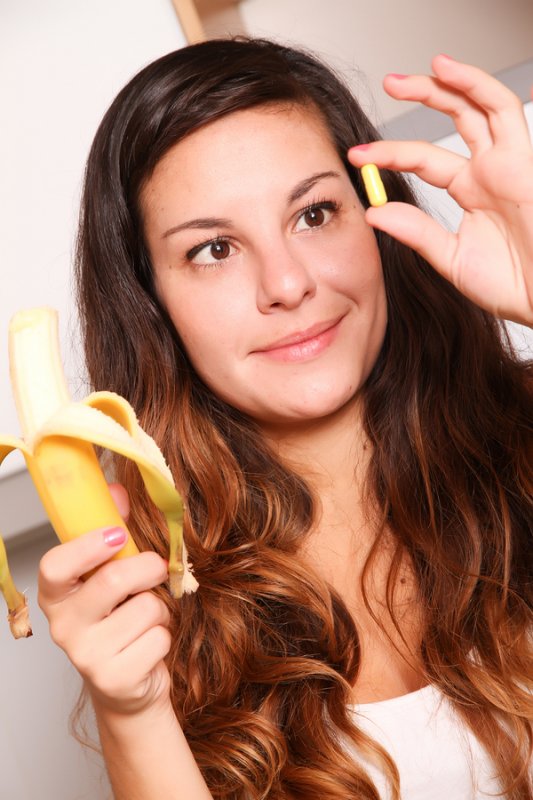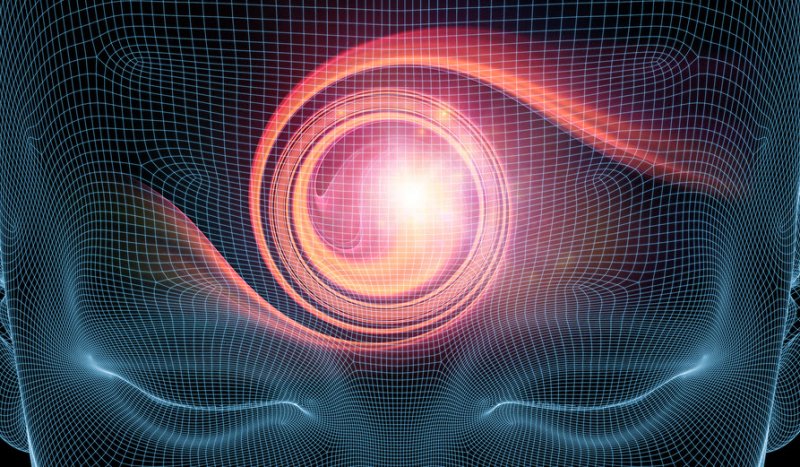Table of Contents
NADH (Nicotinamide Adenine Dinucleotide + Hydrogen, or coenzyme 1) is the active coenzyme form of Vitamin B3 (niacin). Every cell in your body contains NADH.
NADH is the primary carrier of electrons in the transfer of food from your diet into energy. This energy is stored as adenosine triphosphate (ATP). ATP is produced in your mitochondria and your main energy supply for each of your cells. Not enough NADH leads to ATP depletion, which can eventually lead to cell death.[i]
Studies have shown that supplementing with NADH improves cognitive function, enhances cellular energy, increases endurance, switches ‘off’ aging genes, and extends life span.
NADH helps:
- Protect brain cells. NADH repairs cell and DNA damage. And stimulates your immune system. NADH boosts the production of Nitric Oxide (NO) which relaxes blood vessels in your brain increasing cerebral blood flow. And NADH acts as an antioxidant helping to eliminate free radicals that can damage brain cells.[ii]
- Brain energy. NADH provides electrons for ATP synthesis in your mitochondria. Low levels of NADH result in brain fog, slow mental processing, and cognitive decline.
- Neurotransmitters. NADH affects cognitive function by stimulating the production of dopamine, norepinephrine and serotonin.[iii] These neurotransmitters are involved in learning and memory, cognition, recall and mood.
Overview
NADH (Nicotinamide Adenine Dinucleotide + Hydrogen) is the active coenzyme form of Vitamin B3 (niacin). Discovered early in the 1900’s, it’s also known as Coenzyme 1.

NADH is found in, and critical for the health of every cell in your body. NADH is the reduced form of NAD+(Nicotinamide Adenine Dinucleotide), making it the “active” form which can donate electrons.
NADH is the primary carrier of electrons from glucose and lactate for ATP synthesis. ATP is the cell fuel source produced within mitochondria. The power supply in each of your brain cells. So you need NADH to transfer the energy from the food you eat into a type of energy your body can use.
You get small amounts of NADH by eating meat, poultry and fish. Vegetables have very low concentrations of NADH. So vegetarians are typically low in NADH. And since NADH is very unstable, much of it is lost through cooking.
When you supplement with NADH, cerebral electrical activity increases in areas of your brain used for attention, cognition, focus, memory, concentration, and decision making.
How does NADH work in the brain?
NADH boosts brain health in several ways. But two in particular stand out.
- NADH increases the production ATP. NADH carries the electrons needed for the synthesis of ATP. Your brain cell mitochondria depend on NADH for ATP synthesis to function and stay healthy.
By providing the means for ATP synthesis, NADH is involved in cognition, focus, concentration, memory, and processing speed.[iv] And NADH plays an important role in mediating brain aging and tissue damage. Even decreasing the damage done by strokes.[v]
In one double-blind, placebo-controlled study researchers did a 3-month trial with Chronic Fatigue Syndrome patients. 86 patients were chosen to receive either 20 mg of NADH daily or a placebo for the first 2-months. Mean age of the participants was 47 years.
The study measured the intensity of fatigue, functional performance, mood state, functional impact of fatigue, quality of life, sleep quality, and exercise capacity. Each was measured prior to the study. And then at 30, 60 and 90 days of treatment.
The study found that oral administration of NADH resulted in decreased anxiety and maximum heart rate.[vi]
- NADH increases neurotransmitters. NADH is directly involved in the production of the critical neurotransmitters dopamine and norepinephrine.
Dopamine is usually made inside the neurons that use it. The amino acid tyrosine is first converted to L-DOPA through the enzyme tyrosine hydroxylase. L-DOPA is then converted to dopamine.
Research shows that tyrosine hydroxylase is the rate-limiting controller of dopamine synthesis. This is seen in Parkinson’s patients where tyrosine hydroxylase is much lower than in healthy people.
To complicate things even more, we need to understand what makes tyrosine hydroxylase work. The coenzyme that activates tyrosine hydroxylase is tetrahydrobiopterin (H4BP). And it’s NADH that activates this enzyme, and helps produce H4BP.
Researchers in Austria conducted an open label trial with 885 Parkinson’s patients. The study was conducted to try a therapy that might increase the brain’s own dopamine production instead of directly giving the patents L-DOPA.
In this study, 415 patients received intravenous (IV) NADH and 470 patients got an oral dose of NADH. Both groups showed overall good response to treatment including improvements in motor function, walking, pushing, posture and speech. They also experienced improvements in cognition and mood.
The researchers found increased dopamine metabolites in the urine of the patients. Indicating that NADH induced an increase in dopamine production. Most of the Parkinson’s patients were able to reduce and even eliminate their other Parkinson medications.[vii]
How things go bad
As we get older, NADH levels decline. And no amount of healthy eating or exercise can stop this decline.
↓ Dopamine and norepinephrine levels decline
↓ Intra-cellular genome communications break down
↓ Energy levels decline
All of these age-related changes are contributing factors to the neurodegenerative diseases of aging, including Alzheimer’s and Parkinson’s.
But even if things haven’t degenerated to such a debilitating level, NADH can help. In fact, it’s required for dopamine synthesis.
NADH benefits
Research has shown that people with low NADH levels are far more vulnerable to addiction, disease and other chronic conditions. Low NADH levels can happen at any age. Even at birth.
In our Western society, NADH is lost in cooking and food processing. And what little remains is broken down by stomach acid and degraded before it’s absorbed in your digestive tract.
When you take NADH as a supplement, your cells think oxygen levels are normal and start working as if they were younger, undamaged cells.
Research from hundreds of studies have shown that NADH will:
- Boost energy levels and stamina
- Reduce fatigue
- Reduce the possibility of age-related diseases
- Lower blood pressure
- Provide protection and energy to your brain
- Boost cerebral blood flow
How does NADH feel?
Using NADH as a nootropic can boost ATP synthesis in your brain. And increase the production of the neurotransmitters dopamine, norepinephrine and serotonin.
You should experience a boost in mental and physical energy levels, a better mood, improved cognition and alertness.
NADH even helps relieve symptoms related to jet lag. And has been shown to alleviate the symptoms of Chronic Fatigue Syndrome including less brain fog, improved mood and energy, and better cognition.
And neurohackers report more endurance during workouts and running.
NADH Clinical Research
NADH helps reduce Jet Lag
Current remedies for jet lag don’t work very well. Chronic commuters have resorted to melatonin, stimulants, sedatives and phototherapy. And all have produced dismal results in recovering from jet lag.
NASA investigated the efficacy of using NADH as a countermeasure for jet lag. NADH increases cellular production of ATP and facilitates dopamine synthesis. So the thinking was NADH could counteract the effects of jet lag on cognitive function and sleepiness.
35 healthy frequent travelers were recruited in this double-blind, placebo-controlled study. Testing was conducted on the West Coast before subjects flew overnight to the East Coast.
Subjects were given either 20 mg of sublingual NADH, or a placebo. All underwent testing to assess cognitive function, mood, and sleepiness in the morning and afternoon the day after the red-eye flight.
Jet lag resulted in sleepiness for half the participants, and a third of them experienced deterioration of cognitive function. The morning following the flight, subjects experienced lapses of attention, disruptions to working memory, divided attention and visual perceptual speed.
Those who received NADH performed significantly better on cognitive and motor tests, showed better performance on other measures, and reported less sleepiness than those who took a placebo.
NASA concluded that, “Stabilized NADH significantly reduced jet lag-induced disruptions of cognitive functioning, was easily administered, and was found to have no adverse side effects”.[viii]
NADH regenerates stem cells in the brain
Researcher Hongbo Zhang wanted to understand how the regeneration process deteriorated with age. So he teamed up with colleagues from ETH Zurich, the University of Zurich and universities in Canada and Brazil.
 Under normal conditions, stem cells react to signals sent by your body, and regenerate damaged organs by producing new specific cells. Fatigue in stem cells is one of the main causes of poor regeneration. Resulting in degeneration in tissues, organs and the brain.
Under normal conditions, stem cells react to signals sent by your body, and regenerate damaged organs by producing new specific cells. Fatigue in stem cells is one of the main causes of poor regeneration. Resulting in degeneration in tissues, organs and the brain.
The research team set out to revitalize stem cells in the muscles of elderly mice. They gave nicotinamide riboside to 2-year-old mice (which is considered “old” for a mouse). Nicotinamide riboside is a precursor to NADH.
The results showed muscular regeneration was much better in mice that received nicotinamide riboside. They lived longer than the mice that didn’t get it.
Parallel studies have revealed a comparable effect on stem cells of the brain and skin. This work on the aging process has potential for treating diseases that can affect, and be fatal even in young people, with illnesses like muscular dystrophy.
No negative side effects were observed in any of the studies following use of nicotinamide riboside, or stabilized NADH. It appears to boost the functioning of all cells. Including cells that have been damaged.[ix]
NADH decreases anxiety
Studies show that NADH may be low in those suffering chronic fatigue syndrome (CFS). So researchers in Spain set out to evaluate the efficacy of supplementing NADH in those with CFS.
The research team recruited 86 CFS patients with a mean age of 47 years to take part in a 3-month double-blind, placebo-controlled trial. The patients were given 20 mg of NADH or a placebo for 2 months.
The team found that those using NADH experienced a significant decrease in anxiety symptoms. And maximum heart rate dropped.[x]
NADH reduces symptoms of Chronic Fatigue
Chronic Fatigue Syndrome (CFS) has baffled researchers and the medical community for years. Its cause is unknown, and it’s associated with a myriad of symptoms.
But the main common denominator in all Chronic Fatigue cases is severe fatigue. And no therapeutic regimen has proven effective for this condition.
In this study, 31 patients fulfilling the criteria for CFS were selected to participate. They were given NADH or other nutritional supplements for 24 months.
The 12 patients who received NADH had a dramatic and statistically significant reduction of chronic fatigue symptoms.[xi]
NADH Recommended Dosage
NADH is a coenzyme, antioxidant form of Vitamin B3 (niacin). It’s a naturally occurring enzyme found in all living cells. And necessary for cellular ATP synthesis and energy production.
NADH is available in tablet form as 5, 10 and 20 mg tablets. It’s faster-acting if you can find sublingual tablets.
If you’re looking to boost dopamine, stack your NADH with L-Tyrosine. Because NADH converts tyrosine to dopamine.
NADH Side Effects
Your body naturally produces NADH. So it’s non-toxic and very well tolerated. NADH should not produce side effects.
Types of NADH to buy
NADH is highly unstable and for it to remain effective needs to be in a stabilized form.
Most neurohackers recommend the patented, stabilized form of NADH that’s made by a German company called ENADA. A couple of major supplement manufacturers license the ENADA brand of NADH. Check the label.
Another great option is Pure NADH which is 100 % vegan-friendly, lactose-free, Halal certified, manufactured under GMP, ISO 22000, HACCP standards, and 3rd party tested.
I use and recommend: Click for Pure NADH
Nootropics Expert Recommendation
NADH 10 mg per pay
 I recommend using NADH as a nootropic supplement.
I recommend using NADH as a nootropic supplement.
Your body does make some NADH on its own. And from eating meat, poultry and fish. But studies have shown we don’t get an adequate supply of NADH from food sources because most of it is lost in cooking.
NADH is particularly helpful for vegetarians because very little NADH is available from vegetables.
NADH is especially helpful for those suffering Chronic Fatigue Syndrome.
We suggest starting with a dose of 10 mg daily. And NADH is a great compliment to a stack with any nootropic. Do your best to find a stabilized form of NADH like the patented ENADA.
For a more effective dopamine boost, stack your NADH with L-Tyrosine. NADH converts tyrosine to dopamine.
You need to provide the mitochondria in your brain with the nutrients required to make ATP which is your main source of cellular energy. Or neurons start to break down from the inside. NADH carries the electrons needed for the synthesis of ATP. Signs that your lacking adequate NADH is brain fog, slow thinking, fatigue and low endurance.
Some clinics in the USA and other countries are using NADH or NAD+ therapy as a treatment for addiction, anxiety, depression, chronic stress and post-traumatic stress disorder (PTSD).
Intravenous (IV) NADH has been used effectively since the 1960’s for detoxing patients from alcohol, opiates, tranquilizers and stimulants.[xii]
I use and recommend: Click for Pure NADH









Join The Discussion - 110 comments
Malik
October 9, 2021
Do you feel as if this would be beneficial for someone with ADD?
David Tomen
October 11, 2021
Malik, it may help. There is one clinical study which I can’t find the link to right now that used 25 mg NADH per day and apparently the subjects experienced an improvement in symptoms. But it may take several days or even a couple of weeks of daily dosing before you’ll begin to experience its benefits.
Joegrane
February 13, 2025
Malik, NADH sublingual produced an effect similar to low dose Adderall for me but I would have needed to take it more than once per day. I was also taking tyrosine (and DLPA) as David suggests.
Alex
September 11, 2021
As an ADHD person taking Ritalin, how should I take NADH? If its been used for detoxing from stimulants won’t it cancel or work as an agonist for Ritalin?
David Tomen
September 11, 2021
Alex, where are you getting this stuff about detoxing from stimulants?
NADH induces an increase in dopamine production which benefits Ritalin because it gives the stimulant more dopamine to work with.
Wong
May 7, 2021
Yes I read. What I mean do have standalone ENADA to recommend?
David Tomen
May 7, 2021
Aha! This is about as pure as you are going to find. Or what I have access to: https://amzn.to/3vNtQLs
wong
May 5, 2021
Hi david
Any standalone NAD that is pure with no other ingredients that you can recommend?
David Tomen
May 5, 2021
Wong, this is the only one I can find that has zero “other ingredients” but it is in powder form: https://amzn.to/33fszAG
Wong
May 6, 2021
How about ENADA?
David Tomen
May 6, 2021
Wong, did you read my entire review all the way to the bottom?
Sveta
March 27, 2021
Hello David, I’ve been doing my research on what to take for my health issues for years, trying a lot of supplements and am really happy to find your expertise. But I am still a bit confused.
I have had CFS for 12 years and insomnia (both problems falling asleep and waking up several times and not able to get back to sleep). In general, I don’t have problems with anxiety, depression etc.
I take medication for my uderactive thyroid and also painkillers (paracetamol +codein).
I need to look after my liver health, cholesterol and often high blood pressure -don’t want to take meds for any, only supplements.
Currently I take daily N-A-C 600mgX2, CDP (Cognizin) 250mg +AGPC 300mg, Milk thistle, B+ complex (Life Extension- on your advice),
Multivitamin, DHA+EPA, Q10 300mg or 100mg Ubiquinol, B3 (IH form) 500mg.
For sleep I’ve tried melatonin, tart cherry (CherryPure) -didn’t help much and heavy head next day. GABA + L-theanine,L-tryptophan, B3(IH) -no effect (tried for a few days, not long). Mg Glycinate feels a little bit better for some nights to fall asleep.
I’ve looked through the list on your site here and some of the nootropics can effect thyroid or liver function. for example. Here, in the UK, I can check my thyroid levels and other blood tests only once a year, so I want to be safe what I take. And lots of stuff available in the USA are illegal here (f.e. Picamilon, Phenibut etc.)
Am I correct that Q10+B3 is not enough for my CFS and I need NADH(will need to order from the USA)?
Can you please advice how much of NADH to take as in resarch they used 20mg but it sells 5mg. And when should I take NADH, B3, CDP, AGPC, L-theanine to have energy in the morning and good sleep at night?
Also what should I try to take longer for sleep long with Mg Glycinate (L-tryptophan?)?
Thanks a lot!!
David Tomen
March 28, 2021
Sveta, the studies for chronic fatigue and NADH that I’ve seen are for 10 mg per day: https://pubmed.ncbi.nlm.nih.gov/10071523/.
I would avoid L-Theanine in the morning if you are dealing with CFS and save it for before bed. Use the others in the morning.
And consider incorporating these as well that may help you with fatigue: https://nootropicsexpert.com/best-energy-supplements-to-buy/
Sveta
March 29, 2021
Thank you very much for your reply! If I start taking PerformanceLab Energy should I try it on its own or do I need to add NADH as well?
And I’ve read that B3(IH form) can help insomnia, I am confused -when should I take it?
Thank you!
David Tomen
March 29, 2021
Sveta, I’d try Performance Lab Energy on its own first. You can add NADH in a couple of days and see if it helps.
And some people say that if they use Vitamin B3 before bed it helps them with insomnia. If insomnia is one of your issues then it is worth trying in my opinion.
Sveta
March 29, 2021
David, thanks again!
One more question: PerfomLab Energy says to take 2 capsules on empty stomach, is the form of Q10 in it water soluble and I don’t need to take it with food/coconut oil as you recommend?
David Tomen
March 29, 2021
Sveta, Performance Lab Energy uses CoQ10 in the form of patented MicroActive® Q10 which is a cone shaped structure of sugar units where the inside is fat-soluble and the outside is water soluble. Studies show this structure allows for the delivery of CoQ10 molecules through cell walls into your system. So you do not need a healthy fat to ensure absorption of this form of CoQ10.
Joegrane
February 13, 2025
Sveta, are you sure the NAC is causing more benefit than harm? Some people do well with it but others report a worsening of their situation. Also learn about support for methylation and adrenals. They can be wonderful for some people with CFS but can be tricky to take safely.
Amy Lo
March 18, 2021
Hi David, can I take NADH together with probiotics on an emptied stomach?
David Tomen
March 18, 2021
Yes
Jesse
March 9, 2021
is NADH just vitamin B3?
David Tomen
March 9, 2021
Jesse, NADH is the active coenzyme form of Vitamin B3 (niacin). And it is the reduced form of NAD (Nicotinamide Adenine Dinucleotide), making it the “active” form which can donate electrons.
In other words, Niacin is a precursor to the coenzymes nicotinamide adenine dinucleotide (NAD), and nicotinamide adenine dinucleotide phosphate (NADP).
Marius
September 10, 2020
Hi David!
Thanks for so much good information!
Can I take NADH on empty stomack in the mornings (while fasting a little to activate sirtuins).
And combine it with CO10, Quercetin and Reservatrol for improving
synergy?
I am primarly aiming to take this for combo for anti-age and cellulair repair/healing from aging and stress. I also seek to get better skin/hair health etc. with this.
I have seen you talk alot about the coginitive benefits, which is great. But I wonder if this may be as good for those things I listed above as well? And how to for example make the best out of it?
Thanks in advance!
David Tomen
September 10, 2020
Marius, sounds like an effective anti-aging stack and “yes” to taking it in the morning. NADH has been shown to regenerate stem cells in the brain.
I suggest checking out L-Carnosine for its anti-aging benefits as well.